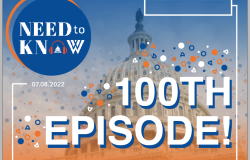Congress’ Budgeting Would Baffle a Martian
If a martian landed here today with the mission to bring back information on how Congress makes budgets, he might report back there is no sign of intelligent life in Washington — at least when it comes to budgeting. On the other hand, he might conclude the opposite: The budget process is so convoluted and complex that officials have obviously encrypted the whole thing so no other country or planet can crack the code as to how U.S. budgets are really made.
That scenario occurred to me recently when I was interviewed by an aspiring young journalist who asked how it was that Rep. Lamar Smith, R-Texas, was the chief sponsor of the omnibus appropriations bill signed into law in January. As Smith is not a member of the Appropriations Committee, let alone its chairman (he chairs the Science, Space and Technology Committee), it indeed would have been curious if the leadership had tapped him to carry the big government funding bill.
As it turns out, the Smith measure began as a one-page bill extending the license application deadline for commercial space launch indemnity insurance. In December it passed the House under suspension of the rules (a process for noncontroversial matters), and then the Senate with an amendment. In January, Smith’s bill was used as the vehicle in which to stuff the 1,500-page, $1.012 trillion omnibus government funding bill. Think of it as the cargo-hold of a space shuttle being used to transport gobs of greenbacks.
The House Rules Committee provided the rocket fuel by making it possible for Appropriations Chairman Harold Rogers, R-Ky., to offer the substitute amendment fully funding the government. The amendment, worked out in advance by Rogers and his Senate counterpart, Chairwoman Barbara A. Mikulski, D-Md., easily sailed through both houses.
That was just the tail-end of a budget process begun the previous spring. Both houses passed their respective budget resolutions before mid-April under the threat of members’ pay being docked for every day past April 15 one wasn’t adopted. That one-year, “no budget, no pay” provision, enacted the previous January as part of a debt limit deal, did not penalize members if they did not reach a final budget agreement. Consequently, for five months, neither chamber moved to go to conference over their widely differing spending levels.
The 16-day government shutdown in October finally broke the logjam. But how it played out surely left our martian visitor scratching his antennae. The continuing appropriations resolution that reopened the government in mid-October extended funding only through Jan. 18. Simultaneously, House and Senate leaders committed to going to conference on their budget resolutions to establish mutually agreeable overall spending levels that could be used for deciding specific appropriations allocations. The Senate concurrent resolution on the budget was chosen as the vehicle for a conference committee, and conferees were instructed to report back by Dec. 13.
What emerged in December, instead of a conference report on the concurrent budget resolution (which is not subject to presidential signature), was a House joint resolution (which does go to the president). The joint resolution was left over from the previous September, the first of several House-passed continuing resolutions with conditions — this one with an Obamacare repeal attached (which the Senate stripped).
The joint resolution’s language was supplanted by a substitute Bipartisan Budget Act negotiated by the Senate and House Budget chairmen, Sen. Patty Murray, D-Wash., and Rep. Paul D. Ryan, R-Wis. It had to be the first time in which Congress sent one measure to a conference committee and a completely different measure emerged. It was not a conference report but in this case an amalgam of budget resolution, sequestration modifier, reconciliation bill (raising revenues and cutting entitlements) and two-year discretionary spending ceilings.
In effect the bipartisan budget bill collapsed several layers of the budget process into a single step to expedite the final round of appropriations decisions in January. Technically another budget resolution is due this April, though Senate Majority Leader Harry Reid claims, as he did last year, that the two-year statutory spending caps obviate any need for one.
The larger question is whether this unusual but belatedly successful budget exercise could point the way to a comprehensive rewrite of the congressional budget act that would include two-year budget resolutions, enforceable spending caps and appropriations. On Feb. 11, the House Budget Committee reported just that, a biennial budget and appropriations process bill with bipartisan support. But enough said; that’s already far too much information for our already befuddled martian.
About the Author

Donald Wolfensberger
Former Director, the Congress Project, Wilson Center; Former Staff Director, House Rules Committee










